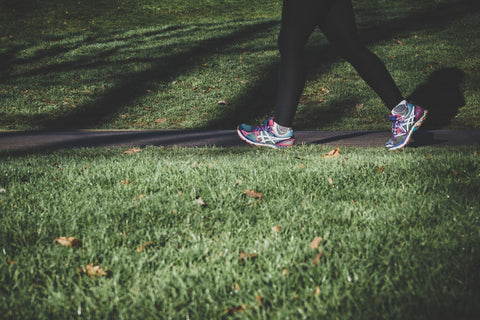If you look around, it may seem like everyone is wearing a fitness tracker and counting their daily steps. Heck, you may even be wearing one as you read this guide.
Though this type of wearable tech helps you monitor stats like your heart rate, stress levels, and sleep quality, most people use it to reach their goal of walking 10,000 steps per day.

So when did walking 10,000 steps a day (which is equivalent to walking 5 miles a day) become a healthy goal to reach? Is brisk walking every day really the key to keeping fit and preventing serious medical conditions?
Or is this ideal just another adage like, drink eight cups of water per day or an apple a day keeps the doctor away?
We’re diving into what the research says to answer these questions and more, starting with:

Where Did the Daily 10,000 Step Target Come From?
Medical professionals agree that sedentary activities like commuting in traffic, working at a desk, and binge-watching Netflix on the couch can all lead to less-than-stellar outcomes for your mental and physical health.
So who decided that walking 10,000 steps a day was enough to combat these sometimes unavoidable sedentary hours?
The idea actually came about in 1965. A Japanese company created a pedometer (i.e., step tracking device) called Manpo-kei, which literally translates to 10,000 steps meter. The Japanese character for 10,000 steps even looks like a person walking!
So even though the 10,000 average steps per day goal may have come from a marketing department, researchers now say that boosting your average steps can deliver some mighty health benefits.

Here’s What the Research Shows About Walking 10,000 Steps a Day
Researchers have studied how walking 10,000 steps a day can help improve your mental and physical health for over 30 years. We even discussed the power in daily walks here on our blog.
So here’s what the science shows so far:
When participants in one small study reached 10,000 steps per day over the course of 12 weeks, they significantly:
- Reduced body weight and body fat
- Decreased waist circumference
- Lowered overall BMI
- Improved their anxiety, depression, and fatigue rates
Scientists from another study confirmed these findings. They noticed that when participants hit 10,000 steps per day, they were able to boost their mental health and overall wellbeing.
These effects have proven to be even greater for people who reach 12,000 steps per day! This active bunch boasts a 65% lower risk of dying as compared to people who only walk 4,000 steps per day. Plus, they have a lower risk of dying from heart disease and cancer specifically.
But what if you don’t meet the 10k steps daily goal?
Researchers in one trial learned that reaching 8,000 steps per day not only lowered a person’s risk of death, but the effects lasted over the next decade. Other scientists discovered that you can still reap these health benefits at just 7,500 steps per day.
And one study showed women who averaged a mere 4,400 steps per day still had a 41% decrease in mortality rates.
These studies all highlight the benefits of adding more active time and brisk walking to your day. And they prove you can work your way up to 10,000 steps per day by setting and reaching smaller goals -- 4,000, then 5,000, then 8,000 -- and still do your body good in the short- and long-term.

Final Thoughts on Hitting 10,000 Steps Per Day
While the idea of walking 10,000 steps a day came from a Japanese company trying to market their pedometer in the 1960s, the science shows it’s actually a worthwhile goal to hit for better health.
If you’re physically able to reach 10,000 steps each day, you’ll do a world of good for your physical, mental, and emotional health.
And if 10,000 steps seems too far out of reach right now, you can work up to this goal each day or week. You may start out struggling to reach 5k steps each day, but average over 10,000 naturally by the end of your first month.
You may even turn wearing your fitness tracker into a competition to see who in your family or circle of friends can reach the goal of walking 10,000 steps a day first (or clock the most steps per day!).
In addition to brisk walking 5 miles a day, you can also find creative ways to sneak in more steps. Try taking the farthest parking spot at the grocery store, walking your dog one extra block each time, or hiking after work and on weekends. If you can, try walking to the coffee shop instead of driving, or play tag with your kids.
Whatever you do, you’ll probably wish you did it sooner when you start noticing all the fantastic effects on your health.
Author: Devan Ciccarelli
Email: devan@behappynothangry.com
Instagram/Facebook Group: @behappynothangry/Be Happy Not Hangry
Website: www.behappynothangry.com




